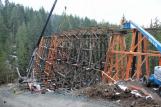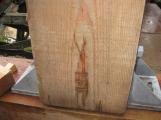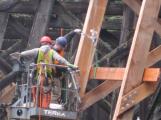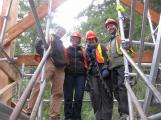7
Dave O'Laney describes challenges the project team faced20 January 2011
Kinsol Trestle, Cowichan Valley, Vancouver Island, BC Canada
 Credits:
Credits:Dave O'Laney, Speaker
Cowichan Valley Musuem & Archives
8
As the rehabilitation work proceeded, the team must responded quickly to problems that arose, while undertaking repairs that retain the maximum amount of historic fabric. New technologies were applied to historic timber pieces that are especially vulnerable in BC's wet climate.AUDIO: Dave O'Laney
I do know from a maintenance perspective the one thing we are doing is we are treating the wood, not treating it with any kind of harsh chemicals, like creosote or the other chemicals that are there. We are using something called Cobra Rods, which are these one-inch-thick rods, maybe six inches long. What we did is we drove them into the wood that is most susceptible to decay, to moisture, anywhere around the bolt locations, and this is all based on our condition assessment of where the historic wood is decaying the most, typically around the bolts and anywhere that's touching the ground - the bottom sills, for instance, are in some of the worst condition. So what we're doing is putting untreated wood down but we're shooting these rods, which are called Cobra Rods, into the wood. And what they do is that they maintain their integrity until the wood inside reaches 25 per cent moisture, and then they release and they shoot a chemical out that soaks up the moisture. And so it's a very interesting kind of process and way to tackle the inevitable decay that happens with all wood outside.
Maintenance of the trestle presented engineering challenges, such as replacing the sills at ground level. Over the course of the rehabilitation former CN workers visited the site often offering solutions.
AUDIO: Dave O'Laney
One thing that's interesting to us is we have to take out a few posts in situation - all the inactive bents in situ - so we have to devise a way to lift a bent up two inches, all together at one time, so that, let's say, so that one sill can be removed and a new one put in. Now Gord's (Macdonald) done a lot of research into that because it's not an easy question to answer; a lot of structural engineers have looked at it and kind of scratched their heads and wondered how we're going to do it. We have relied heavily on historical documents and Gord has gone to and read these CN reports on how they did it. We will most likely use a very old technique to do it because, quite frankly, it's the best technique anybody's ever come up with. Now, that being said, we'll probably put our own little twist on it, with new materials and new technologies, but in the end, it's probably going to be an awful lot of jacks, slowly lifting it up one or two inches.
Kathryn Gagnon:
I think that was a problem that was discussed when I brought a fellow named Gerry Flowers to the site...
Dave O'Laney:
Yeah, I recall.
Kathryn Gagnon:
And I think Gord has asked him about that specific problem.
Dave O'Laney:
And I believe Gerry had an answer for him in fact, and although we haven't been able to put into practice and we don't know how it's going to work yet, the philosophy is based around the idea of what Gerry and some of the other workers on the bridge had, yeah, absolutely. Sometimes the simplest ideas are the best. But that being said, we haven't got to that phase yet, so it will be interesting to see how we adapt the old techniques to the new situation.
9
Dave O'Laney explains use of new technologies20 January 2011
Kinsol Trestle, Cowichan Valley, Vancouver Island, BC Canada
 Credits:
Credits:Dave O'Laney, Speaker
Cowichan Valley Musuem & Archives
10
Dave O'Laney addresses challenges of project20 January 2011
Kinsol Trestle, Cowichan Valley, Vancouver Island, BC Canada
 Credits:
Credits:Dave O'Laney, Speaker
Cowichan Valley Musuem & Archives
11
Placing first new steel truss on north side2011
Kinsol Trestle, Cowichan Valley, Vancouver Island, BC Canada
 Credits:
Credits:Macdonald & Lawrence Timber Framing, photo credit
12
As the Kinsol Trestle is a heritage conservation project, the team is expected to retain the character-defining elements, such as the inspection ladders and the old telegraph poles. Before the rehabilitation began, the poles were photographed, and their locations on-site were measured. One of the poles was removed for safekeeping and will be returned to its original location at the end of the project. Dave O'Laney notes that, "Heritage details around the project, the way the Roman numerals are carved or scribed into the wood...is something we've continued with the new pieces of wood: every new piece of wood has the old Roman numerals on them, just because we want to stay consistent and true to the project."AUDIO: Dave O'Laney
Part of good heritage conservation, or good heritage conservation practice, is making the new wood distinguishable from the old. We're not trying to copy the wood exactly; we're not trying to make it look exactly like the old wood. We want to be able to tell, and we want the average person to be able to tell, what's new and what's old. As the new wood ages and becomes closer in patina to the old wood, that would get more and more challenging.
13
Dave O'Laney discusses a tenet of heritage conservation20 January 2011
Kinsol Trestle, Cowichan Valley, Vancouver Island, BC Canada
 Credits:
Credits:Dave O'Laney, Speaker
Cowichan Valley Musuem & Archives
14
Identification code, hand chiseled into new timbers18 January 2011
Kinsol Trestle, Cowichan Valley, Vancouver Island, BC Canada
 Credits:
Credits:Shawnigan Lake Historical Society
15
In 2004-2005, when a replacement version of the bridge was proposed to the CVRD, there was a real threat that the original bridge would be demolished. Had this approach been adopted, the loss of original historic material would have made the Kinsol Trestle ineligible for historic designation. Previous efforts by others to petition for designation would have been for naught. Gordon Macdonald discusses his motivations for presenting an alternative approach to a new bridge:AUDIO: Gordon Macdonald
I guess my motivation was twofold: in the first instance, I saw that the proposed new bridge consisted of poor-quality timber that had been pressure-treated in order to make it durable. It's a bit of a hobby horse for me. I don't like specifying these sorts of chemical treatments, if possible, and the thought of putting, of removing all of the existing structure and then putting a new structure back in its place - which was going to use a fantastic amount of wood, and chemically treated timber - just seemed environmentally, really quite nonsensical. So, that was the first motivation was, if nothing else, to recommend a kind of treatment that was more sustainable than the one that had been proposed - which is pretty outdated. In fact the form of treatment that had been proposed is a form banned in Europe, and we're probably heading that way ourselves. The second reason I was interested was I looked at some of the initial inspections and studies that had been done and it was really clear that they had all been done from a peculiar, or the particular, perspective of, was the bridge fit or not fit, could it be repaired to the standards of a working railway bridge or highway bridge. Nobody was really looking all that carefully at whether or not it could be repaired. Let me say that again in a different way. All of the previous studies had viewed the bridge from the perspective of, if there's something wrong with it, it should be replaced, therefore a partially decayed element should just be replaced, and as you can imagine, with all of these long and big timbers in the bridge, if you take that view, you end up with an enormous tally of material that has to be replaced. No one had been looking at in terms of repair, and particularly from the perspective of repairs that are common in the heritage world, but maybe less available to people who are working for railway companies and bridge companies, day by day.
Gordon described the dangers posed by not only the absence of any repairs made to the bridge in the previous twenty-five years, but also the decay that set in after long-term exposure to overgrown vegetation. He also considered the importance of retaining those aesthetic characteristics that make the bridge so appealing:
AUDIO: Gordon Macdonald
So the bridge went downhill in a hurry once that rot started to take hold. So all of the people who had been going out there to look at it had been looking at it through this funny lens of, if something is damaged then it surely needs to be replaced, because that's the way that the railwaymen treated the bridge themselves because they have to carry trains. What we were looking at was, with a slightly different value, we said, we sort of approached it by thinking, the bridge itself is quite beautiful in its precarious, decayed form. It is actually quite attractive as well, I don't mean for that to sound silly, it's just that the lovely patina of the old wood is what should be saved, not viewed as a negative. So we tried to look at innovative ways to repair the bridge and initially from the perspective of working our way bent to bent to bent across the bridge, making repairs from one end to the other. And then also we considered the new loading because obviously it's being used as a pedestrian bridge now...rather than carrying trains, so you can apply different criteria.
Ultimately, a conservation approach to repairing and rehabilitating the Kinsol Trestle was adopted by the CVRD.
16
Gordon Macdonald discusses past proposals regarding Trestle26 November 2010
Kinsol Trestle, Cowichan Valley, Vancouver Island, BC Canada
 Credits:
Credits:Gordon Macdonald, Speaker
Cowichan Valley Museum and Archives
17
Men working on active bent about 120 feet above river18 January 2011
Kinsol Trestle, Cowichan Valley, Vancouver Island, BC Canada
 Credits:
Credits:Shawnigan Lake Historical Society
18
Gordon Macdonald considers importance of retaining aesthetic characteristics26 November 2010
Kinsol Trestle, Cowichan Valley, Vancouver Island, BC Canada
 Credits:
Credits:Gordon Macdonald, Speaker
Cowichan Valley Museum and Archives
19
Visit to rehabilitation site18 January 2011
Kinsol Trestle, Cowichan Valley, Vancouver Island, BC Canada
 Credits:
Credits:Shawnigan Lake Historical Society
20
Access has been made available to the public throughout the duration of the project, providing visitors with a fascinating view of a monumental heritage conservation project. Since the rehabilitation began, the site has been visited by many people. Dave O'Laney, who has guided many visitors through the story of the rehabilitation project, observes,AUDIO: Dave O'Laney
People are amazed by the project, it's jaw-dropping once you're out there - the size of everything - and the challenges that we face, it's interesting. That's why I love when visitors do come, or I do a tour for the guests who are coming up to the bridge, because every single person has the same reaction, and that is such a positive reaction to the enormity of the project...there's no getting around the fact that a) this is a huge, huge project and b) it's a very special project, it's very unique in so many different ways.